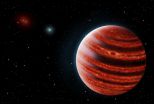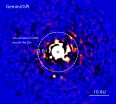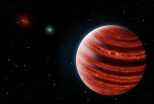Exoplanet discovery from next-gen Gemini Planet Imager
2015-08-13
(Press-News.org) This news release is available in Japanese.
The recently commissioned Gemini Planet Imager has made its first exoplanet discovery: what may be the lowest-mass exoplanet ever directly imaged with a space telescope instrument. Based on available data, the researchers project the planet weighs twice as much as Jupiter - far less than exoplanets directly imaged before, which weighed at least five times Jupiter's mass. The findings from the next-generation Gemini imaging tool pave the way toward a better understanding of how our solar system was formed. In 2013, the Gemini Planet Imager (GPI), a direct exoplanet imaging instrument perched atop Chile's Gemini South Telescope, was deployed. Like other imaging instruments in its class, it was designed to detect planets significantly closer to their parent star, and of significantly lower mass, than any yet found. It is also adept at detecting young planets, which, as they still retain heat from their formation, remain luminous and visible. Using the GPI to study the area around the 20-million-year-old star 51 Eridani, Bruce Macintosh and colleagues found a young planet orbiting at just 13 astronomical units away. By studying its thermal emissions, Macintosh et al. gained insights into its atmospheric composition, which, much like Jupiter's, is dominated by methane (to date, methane signatures have been weak or absent in directly imaged exoplanets). They also say it formed in a similar process to Jupiter. Its unique array of properties suggests it is a "bridge" between hotter planets with wider orbits and those more like Jupiter.
INFORMATION:
Article #17: "Discovery and spectroscopy of the young Jovian planet 51 Eri b with the Gemini Planet Imager," by B. Macintosh; E.L. Nielsen; K.B. Follette; P. Ingraham; J.-B. Ruffio at Stanford University in Stanford, CA; B. Macintosh; M. Ammons; D.W. Palmer; L.A. Poyneer at Lawrence Livermore National Laboratory in Livermore, CA; J.R. Graham; R.J. De Rosa; J.J. Wang; S. Beckwith; E. Chiang; R.I. Dawson; R. Dong; G. Duchêne; P. Kalas; T. Mittal; M. Salama at University of California, Berkeley in Berkeley, CA. For a complete list of authors, see the manuscript.
ELSE PRESS RELEASES FROM THIS DATE:
2015-08-13
The Gemini Planet Imager has discovered and photographed its first planet, a methane-enshrouded gas giant much like Jupiter that may hold the key to understanding how large planets form in the swirling accretion disks around stars.
The GPI instrument, which is mounted on the 8-meter Gemini South telescope in Chile, is the size of a small car and was designed, built and optimized for imaging and analyzing the atmospheres of faint Jupiter-like planets next to bright stars, thanks to a device that masks the star's glare.
In December 2104, GPI began searching hundreds of ...
2015-08-13
A Jupiter-like planet within a young system that could serve as a decoder ring for understanding how planets formed around our Sun has been discovered by a team of astronomers from the University of Montreal's Institute of Research on Exoplanets (iREx) in collaboration with an international team of astronomers led by professor Bruce MacInstosh from Stanford University. One of the best ways to learn how our solar system evolved is in fact to look to younger star systems in the early stages of development.
The new planet, called 51 Eridani b, is the first exoplanet discovered ...
2015-08-13
While it may not shock you to learn that children born with disorders of sex development (DSD) face challenges, Concordia University researchers have confirmed that these go far beyond the physical.
In a paper published in the journal Hormone and Metabolic Research, psychology professor William M. Bukowski and his co-authors Elizabeth McCauley and Thomas Mazur examine the potential effects that these disorders can have on children's and adolescents' peer relationships.
The term "disorders of sex development" covers a range of conditions, from physical malformations ...
2015-08-13
Fifteen years ago, an odd mutant fruit fly caught the attention and curiosity of Dr. Ravi Allada, a circadian rhythms expert at Northwestern University, leading the neuroscientist to recently discover how an animal's biological clock wakes it up in the morning and puts it to sleep at night.
The clock's mechanism, it turns out, is much like a light switch. In a study of brain circadian neurons that govern the daily sleep-wake cycle's timing, Allada and his research team found that high sodium channel activity in these neurons during the day turn the cells on and ultimately ...
2015-08-13
For any complex society to function properly, individuals--be they people or social insects--must reliably recognize their friends and family with whom they live and work and readily distinguish those allies from strangers. Ants and other social insects manage this feat of recognition based on chemical pheromones, which are detected via sensors in their antennae. Now researchers reporting August 13 in Cell Reports have discovered that when it comes to assessing body odors, ants really don't miss a thing.
"To our surprise, these very low volatility compounds are not only ...
2015-08-13
A link between malaria and Burkitt's lymphoma was first described more than 50 years ago, but how a parasitic infection could turn immune cells cancerous has remained a mystery. Now, in the August 13 issue of Cell, researchers demonstrate in mice that B cell DNA becomes vulnerable to cancer-causing mutations during prolonged combat against the malaria-causing Plasmodium falciparum.
Individuals who are chronically infected with certain pathogens are at increased risk of developing lymphomas, cancers of the antibody-producing B lymphocytes. For example, Burkitt's lymphoma, ...
2015-08-13
A study from the US National Institutes of Health presents some of the most precise human data yet on whether cutting carbs or fat has the most benefits for losing body fat. In a paper published August 13 in Cell Metabolism, the researchers show how, contrary to popular claims, restricting dietary fat can lead to greater body fat loss than carb restriction, even though a low-carb diet reduces insulin and increases fat burning.
Since 2003, Kevin Hall, PhD--a physicist turned metabolism researcher at the National Institute of Diabetes and Digestive and Kidney Diseases--has ...
2015-08-13
Irisin, a hormone linked to the positive benefits of exercise, was recently questioned to exist in humans. Two recent studies pointed to possible flaws in the methods used to identify irisin, with commercially available antibodies. In Cell Metabolism on August 13, the Harvard scientists who discovered irisin address this contentious issue by showing that human irisin circulates in the blood at nanogram levels and increases during exercise.
Senior study author Bruce Spiegelman of Dana-Farber Cancer Institute and Harvard Medical School says that the confusion over irisin ...
2015-08-13
The mechanisms that allow the liver to repair and regenerate itself have long been a matter of debate. Now researchers at University of California, San Diego School of Medicine have discovered a population of liver cells that are better at regenerating liver tissue than ordinary liver cells, or hepatocytes. The study, published August 13 in Cell, is the first to identify these so-called "hybrid hepatocytes," and show that they are able to regenerate liver tissue without giving rise to cancer. While most of the work described in the study was done in mouse models, the researchers ...
2015-08-13
In what appears to be an unexpected challenge to a long-accepted fact of biology, Johns Hopkins researchers say they have found that ribosomes -- the molecular machines in all cells that build proteins -- can sometimes do so even within the so-called untranslated regions of the ribbons of genetic material known as messenger RNA (mRNA).
"This is an exciting find that generates a whole new set of questions for researchers," says Rachel Green, Ph.D., a Howard Hughes Medical Institute investigator and professor of molecular biology and genetics at the Johns Hopkins University ...
LAST 30 PRESS RELEASES:
[Press-News.org] Exoplanet discovery from next-gen Gemini Planet Imager







